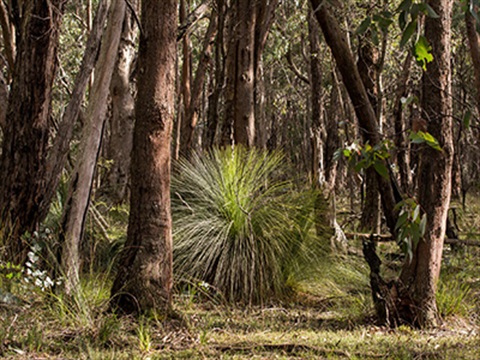Native plants

The Macedon Ranges supports a wide range of indigenous plant communities, growing across different locations, altitudes, and soil types. From sheltered gullies filled with towering Mountain Ash to the open dry forests and grasslands of our volcanic plains.
To better understand and manage this diversity, the region is categorised into Ecological Vegetation Classes (EVCs). An EVC groups vegetation based on shared characteristics such as plant species composition, structure, and ecological function.
Why do native plants matter?
Native plants play a vital role in keeping our landscapes healthy by:
- Providing food and habitat for local birds, insects, mammals, and reptiles
- Supporting pollinators like bees and butterflies
- Helping prevent soil erosion and improve water quality
- Strengthening the resilience of natural ecosystems in a changing climate.
Planting the right native species helps maintain biodiversity and ensures that our natural environment continues to thrive.
Native plants in your backyard
Nature guides
Did you know we have five nature guides where you can expand your knowledge about local flora, weeds, grasses, birds and insects while you are out enjoying nature in the Macedon Ranges? Take them with you by downloading one or all of our nature guides to your device before heading outdoors.
Backyard Biodiversity
Whether you are new to gardening or already love it, our Backyard Biodiversity project will help you transform your backyard into a welcoming home for local wildlife.
Backyard Biodiversity will empower you to:
- create habitat for native birds, insects and wildlife
- choose the right plants to support biodiversity
- make a positive impact on your local environment.
Sustainable Gardening Australia
Sustainable Gardening Australia, together with Western Water have put together a sustainable gardening booklet.
This booklet has information on plant selection of local plant species in our region from page 24. Species include climbers, ground covers, grasses, shrubs and trees.
what to plant on your property
The Macedon Ranges Shire contains many different ecosystems. These ecosystems are grouped into what are known as Ecological Vegetation Classes (EVCs).
What is an EVC?
An EVC is a way of classifying vegetation based on the types of plants that grow in an area, how they grow and the environment they grow in.
Each EVC represents a different type of ecosystem — for example, grassy woodlands, wet forests, or rocky outcrops. These classifications help us understand the natural landscape and how to care for it. These classifications play an important role in guiding land management activities, particularly tree planting, as they help identify the most suitable native species for a given area.
Why EVCs Matter
EVCs are an important tool for:
- Choosing the right native plants for your property or garden.
- Restoring natural areas with plants that belong in the local ecosystem.
- Guiding land management decisions, especially when it comes to revegetation and tree planting
Find native plants for your area
Each EVC includes a species list of native plants that are suited to that ecosystem. By using these lists, you can select plants that are more likely to thrive on your property — and support local wildlife at the same time.
To get started:
- Open Council's online mapping service, Pozi maps.
- Find your property by searching the address using the magnifying glass in the top left hand corner of the page.
- Scroll down the panel on the left hand side until you reach "Ecological Vegetation Class".
- Click to view the EVC that applies to your property (there could be more than one).
- Click on "Native Revegetation Species List".
Pozi map service
Finding and recording native species
iNaturalist is a citizen science platform that helps users record and share observations of biodiversity. It allows you to contribute to valuable scientific data while learning more about local species.
Simply take a photo of flora or fauna, upload it to the app or website, and the iNaturalist community will help identify it.
Using iNaturalist is an excellent way to track your backyard visitors and support conservation efforts.
Let's get started
- For iPhone users: Go to the App Store, search for "iNaturalist," and download the app. For Android users: Go to Google Play, search for "iNaturalist," and download the app.
- Open the app and sign up for a free account with your email. Once registered, you'll be ready to start recording observations.
- Open the app and tap the “Observe” button (camera icon). Observe from a safe distance and avoid disturbing wildlife. Take a photo of the animal, plant, or other organism you want to record (or upload a photo you’ve already taken). If you have several images, you can add multiple photos to the same observation by tapping the "Add" button after taking the first picture.
- Add details to your observation. If you aren't sure iNaturalist can help identify your observation! After adding a photo, you’ll see suggestions for what the species might be. Select the closest match if you’re confident, or leave it open if you’re unsure.
- After adding all the information, tap "Share" to upload your observation to iNaturalist.
Your data will now be part of a larger pool that scientists, researchers, and other naturalists use to track biodiversity!
Legislation and protecting threatened species
The Macedon Ranges is home to many threatened species of plants. There are several key pieces of legislation that classify threatened species. These include: